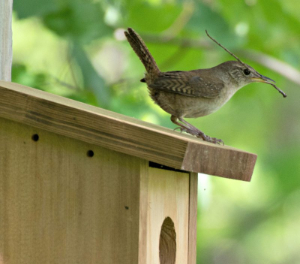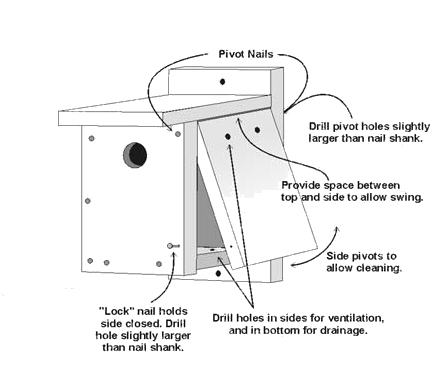Types of Boxes

Most birds are attracted to a natural looking nest boxes. When using wood, make sure that the wood is an untreated naturally decay resistant wood such as cedar or redwood.
Regardless of the type of material, there are some fundamental charateristcs to consider, but the overarching factor is a sense of safety. The house you build need to have dimensions that provide these small birds a sense of safety; minimizing the risks from natutral predators or invasive birds.
- Interior Space: The interior floor space should be about 4 inches squared; 4 inches on all sides. This provides enough space to accommodate 3 to 8 eggs. As the eggs hatch, the size also prevents overcrowding while keeping the hatchlings close enough for warmth and comfort.
- Entrance Hole: The entrance hole should be sized to permit wrens to enter while excluding other species, such house sparrows and European starlings, who could look to evict the wrens and take over the house. Ideally, the entrance hole should be around 1 1/8 inches in diameter, wide enough to facilitate the wren and a variety of nesting material including larger twigs.
- Entrance Height: The entrance should be 3 to 6 inches above the floor of the house. A lower hole can endanger baby birds causing them to fall out as they grow and too tall could trap them when they reach the stage to leave. Height of the House: The overall height should be 6-8 inches tall.
Where and How to Place Boxes
Placement is an important consideration. The house can be placed near human activity, but it should be kept away from the busiest places.
Place the nest box within 100 feet of woodlands between 4 to 10 feet from the ground. I can be attached under the eaves of a building, or on a living or dead tree, or on a pole with open space in front of the box. Boxes for most s[ecies of wrens must be firmly mounted. House Wrens are the one species of wren that will use a free-hanging house that swings in the wind.
Nearby trees or shrubs will provide good shelter for the birds as well as a ready foraging space, but the house should not be buried deep in the foliage. Wrens can be sensitive to cold so the entrance is best angled away from prevailing winds. Place the house where it can benefit fomr some early morning warmth from the sun, but shaded during the hottest part of the day to better regulate the temperature.
How to Build a Box
The plans for building a nesting box are supplied below.
We recommend using rough-sawn (unplaned), cypress or cedar boards. One box requires a plank of wood about 4 feet similar to the plank view diagram. The wood should not be painted, stained, or chemically preserved.
Parts View and Assembly


Siimilar articles:
Free DIY Plans for building Adirondack chairs
How to Build a Wood Duck Nesting Box


